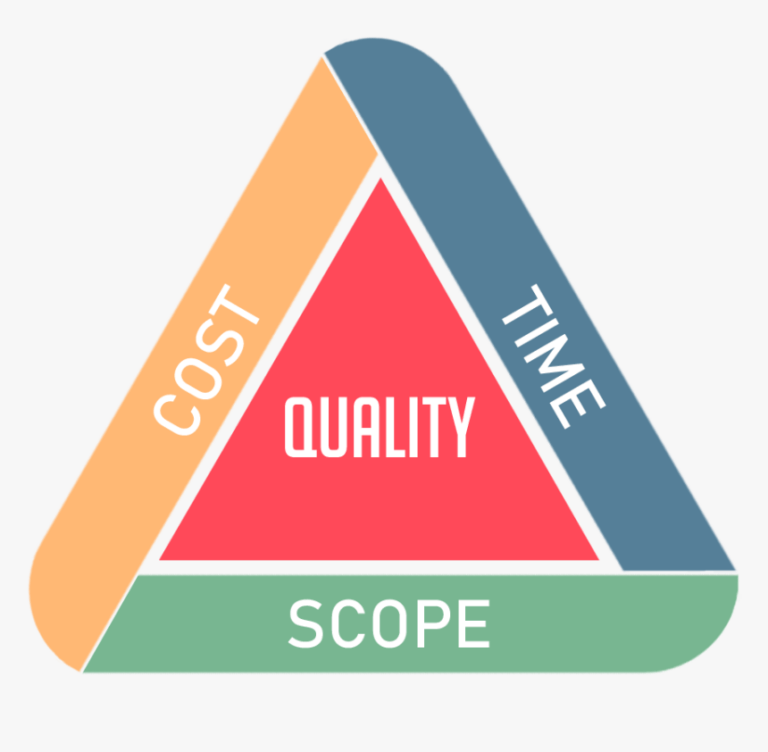
What is a project triangle?
The project triangle is a model in project management that shows how the balance between scope, time and cost affects the quality of a project.
For a project to be successful, project managers need to control all three constraints or limiting factors.
Elements of the project triangle
In order to control all the components of the project triangle during a project, it is important to be familiar with its elements and understand how to manage them in the most efficient and flexible way.
1. Scope
Scope is the size of the project in terms of the quality, detail and magnitude of the project deliverables. The larger the size of the project, the more time and money will be needed to complete it.
The elements of the scope may include:
- the complexity of the project
- finished product(s)
- the quality of the product(s)
- level of detail
- characteristics and complexity, etc.
2. Cost
The cost itself is not limited to the amount of money, but includes all the means and resources needed to carry out the project. It is the total budget.
Examples of cost elements may include:
- Budget
- Team size
- Facilities
- Support
- Utility bills, etc.
3. Time
By time, we mean how long it takes to complete tasks in a project. If the scope is extended, this may increase the time frame. But if, for example, a team member is removed from the team due to budgetary constraints, the project may also take longer to complete
A project may have a number of time factors, such as:
- total project timeline
- time spent on project
- internal calendar
- design time
- project phases, etc.
If the budget is reduced or the scope increases, solutions must be found to relax the time constraints, for example by extending deadlines or adding extra hours, or perhaps by adjusting the schedule.

+1: Quality = time + money + scope
Quality, the fourth element of the project triangle, is at the centre. The beauty of the project triangle is that no variable can be changed without affecting the other two points of the triangle. In projects, therefore, all three elements must be balanced in order to keep the project on budget and on time while meeting the project scope requirements.
The relationship between scope, time and cost
Now let's look in more detail at how changes in scope, time or cost affect the way projects are run.
How does scope affect time and cost?
Scope is directly proportional to time and cost, i.e. it moves in the same direction as the other two factors. What does this mean? If the scope increases, the time and cost must also increase to make a larger project a success.
What about time and costs?
The time and cost are inversely proportional. That is, if costs have to be reduced, deadlines have to be extended. The same is true in reverse. If there is insufficient time, extra costs will be incurred to complete the tasks in a shorter time.
These two relationships are constant, i.e. it is not possible for one component not to influence the other. This is why the project triangle is called the triple constraint model or the iron triangle. However skilled and experienced a project manager may be, he or she cannot bend the iron triangle at will.
Why is the project triangle important?
Now let's see how the project triangle can help project managers.
1. Clarify priorities
Knowing the three constraints makes it easier to set and manage priorities for a quality outcome.
Suppose you have a project with a very tight budget. Because of these constraints, the project manager knows that he has to pay close attention to the scope and duration of the project. Because if the scope increases, the budget has to increase. And extra time may require more paid resources, such as salaries.
2. Easier customer communication
Customers expect quality results from a project, but in many cases they do not know much about project management practices. The project manager's job is to explain changes to them as clearly as possible when they occur. The project triangle provides a clear guide to illustrate the dependencies between cost, time and scope, and informs them how a change will affect these constraints.
3. Reducing risks
Knowing the priorities will significantly reduce the risks, as an effective plan can be put in place to minimise the risks. Suppose a project to implement new software has a tight deadline and you fear that the engineers will not be able to complete the work on time. In this case, for example, a contingency budget (reserve) can be prepared in case additional experts need to be involved in the processes in order to complete the project on time.
How do we handle the project triangle?
Here are some effective practical methods to balance the limits of the project triangle.
1. Identify priorities!
The central concept of the project triangle is that no project can be successful with three rigidly fixed points. At least one point must be flexible, so that we know which areas can be adjusted if changes are needed. It is worth noting here that, from a design perspective, traditional projects tend to fix the scope first, while agile trends tend to fix the time, or possibly cost, dimension much more.
Assuming that our priority is to stick to the budget, we can deal with an unexpected obstacle by extending the deadline. This is more expedient from our point of view than, for example, hiring staff to complete tasks quickly.
2. Be clear about your expectations!
Once we know the priorities, we need to communicate them clearly to both clients and project stakeholders to prevent unmet expectations and possible dissatisfaction during the work.
For example, there are industries where unexpected difficulties are more common. This could be in construction or engineering. It is the project manager's job to include these in the documentation at the contract stage, so that all stakeholders are fully aware of the critical points. For example:
- common potential delay factors (e.g. weather, natural disasters, local events, etc.)
- what events might occur and how they might affect costs and schedule, and what the client's preferences are
- the cost and time involved in an emergency
If these are recorded, they will be a good starting point if adjustments need to be made to the project triangle. This way, the reason for the changes will be obvious when the project is completed.
2. Develop risk and change management processes
It is important to include a risk management plan in the project management processes so that deadlines, budgets and scope can be met. For each of these factors, define the exact steps that can be taken in the event of changes.
This can make the process of approving and rejecting changes efficient and structured, and ensure that team members are fully aware of the changes and their impact.
3. Regular information
Throughout the project, care must be taken to keep all stakeholders informed of changes and forecasts.
For example, if you receive information from a supplier that a required resource is missing, both the customer and the product owner should be informed of the possibility of a delay. If the resource runs out, the stakeholders will not be caught off guard and will be ready to make the necessary adjustments. And if the resource is available, it gives confidence and all parties know that they are prepared for all expected scenarios.
4. Choose a methodology based on the constraints
For projects with strict constraints, the waterfall method is still widely used. If greater flexibility is needed, an agile methodology such as Scrum may be more appropriate. For projects where inefficiencies need to be minimised, a Lean approach may be the most appropriate. However, it is important that the criterion for selecting a method should not be limited to constraints alone.
Conclusion
Although the project triangle system may seem restrictive at first, if you learn to apply it properly in the project management process, you will find that in reality it is supportive of the project and makes implementation much smoother. Knowing the constraints supports flexibility and thus avoids financial failures and loss of quality.
Improve your knowledge too!
Our training courses for methodological knowledge and soft skills development, as well as international certification, help both project team members and project managers find the most suitable training. Choose from our professional programmes!

 Designabc
Designabc